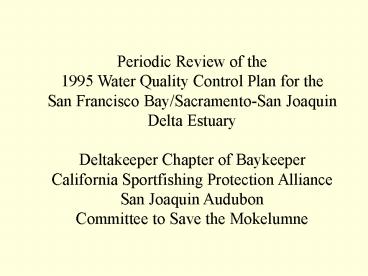Periodic Review of the - PowerPoint PPT Presentation
Title:
Periodic Review of the
Description:
Periodic Review of the 1995 Water Quality Control Plan for the San Francisco Bay/Sacramento-San Joaquin Delta Estuary Deltakeeper Chapter of Baykeeper – PowerPoint PPT presentation
Number of Views:72
Avg rating:3.0/5.0
Title: Periodic Review of the
1
Periodic Review of the 1995 Water Quality
Control Plan for the San Francisco
Bay/Sacramento-San Joaquin Delta
Estuary Deltakeeper Chapter of
Baykeeper California Sportfishing Protection
Alliance San Joaquin Audubon Committee to Save
the Mokelumne
2
We thank the Exchange Contractors and the San
Joaquin River Group for graphically defining the
issues in this workshop.
3
According to the Exchange Contractors
- DMC water contains salt (Frequently above
standards). - Irrigation causes further accretion of salt.
- Salts must be removed to prevent salinization of
soil. - The only available drain is the San Joaquin
River.
4
Consequently, in order to protect agriculture
- The domestic/municipal beneficial uses should be
de-designated. - The San Joaquin River should be recognized and
operated as an agricultural sewer. - The Schwarzenegger Wasteway?
5
Eastside interests have a slightly different twist
- Recent modeling information (which hasnt been
peer-reviewed, calibrated or verified) indicates
that the problem isnt as severe as previously
believed. - Therefore Water quality flows from New Melones
can be reduced (this would also require that the
Stanislaus River dissolved oxygen compliance
point be move upstream).
6
Before we rush to de-designate beneficial uses,
relax water quality objectives or reduce instream
flow, this Board must resolve several
fundamental questions.
7
Given the fact that
- Source water exceeds standards.
- Accretion of salt from irrigation is inevitable.
Can irrigating lands prone to leaching salts with
water that already exceeds salinity standards be
a beneficial use of water under the California
Constitution?
8
Given the fact that
- The Friant Water Users Authority, City of San
Francisco and SSJID/OID operate peripheral
diversions around the lower reaches of the San
Joaquin, Tuolumne and Stanislaus Rivers. - Water must be employed to meet the highest
multiple beneficial uses.
Is the diversion of assimilative capacity around
lower reaches of impaired waterways an
unreasonable method of diversion under the
California Water Code?
9
Since
- The cumulative total of pre-1914, riparian and
appropriative water rights within the San Joaquin
Basin exceeds available water.
Isnt it now time for the State Board to
adjudicate the Basin?
10
Its more than just salt
- The San Joaquin River is impaired by Boron,
Chlorpyrifos, DDT, Diazinon, Electrical
Conductivity, Group A Pesticides, Mercury,
Selenium and Unknown Toxicity. - The Merced River is impaired by Chlorpyrifos,
Diazinon and Group A Pesticides. - The Tuolumne River is impaired by Diazinon, Group
A Pesticides and Unknown Toxicity. - The Stanislaus River is impaired by Diazinon,
Group A Pesticides, Mercury and Unknown Toxicity. - Stockton Ship Channel is impaired by
Chlorpyrifos, DDT, Diazinon, Group A Pesticides,
Mercury, Low Dissolved Oxygen, Unknown Toxicity,
Dioxins, Furans, pathogens and PCBs.
11
Water Quality Control Plans Must Consider
- That all promulgated water quality objectives
must be met. - Compliance is required throughout the water
column and river reach. - Reduction or increases in flow (i.e.,
assimilative capacity) inevitably results in a
decrease or increase in pollutant concentration.
12
Given the fact that
- SJR TMDL proceedings demonstrate that source
control, by itself, cannot achieve compliance
with water quality standards. - Increases in assimilative capacity (i.e., flow)
are also necessary. - Water quality standards must be met throughout an
impaired waterway not simply at a low point on
the watershed.
Shouldnt the burden of restoring assimilative
capacity be equitably distributed between all
upstream diversions/storage?
13
Given the fact that
- Region 5 has blatantly refused to implement the
State Boards explicitly 1999 direction to
immediately move the salt compliance point
upstream on the SJR.
The State Board should immediately adopt upstream
salinity compliance points that are protective of
the entire impaired reach of the San Joaquin
River?
14
It should also be remembered that
- Fishable, swimable beneficial uses exist on the
San Joaquin River. - Water quality standards must protect aquatic life
beneficial uses. - Sensitive life stages of aquatic life are present
in the San Joaquin River all twelve months of the
year.
15
(No Transcript)
16
There are no painless solutions. Any meaningful
control plan must include
- Upstream compliance points.
- Source Control (including targets, compliance
schedules, milestones and consequences for
noncompliance. - Flow augmentation (elimination or reduction of
bypass of assimilative capacity and a fair-share
contribution from all diverters).































